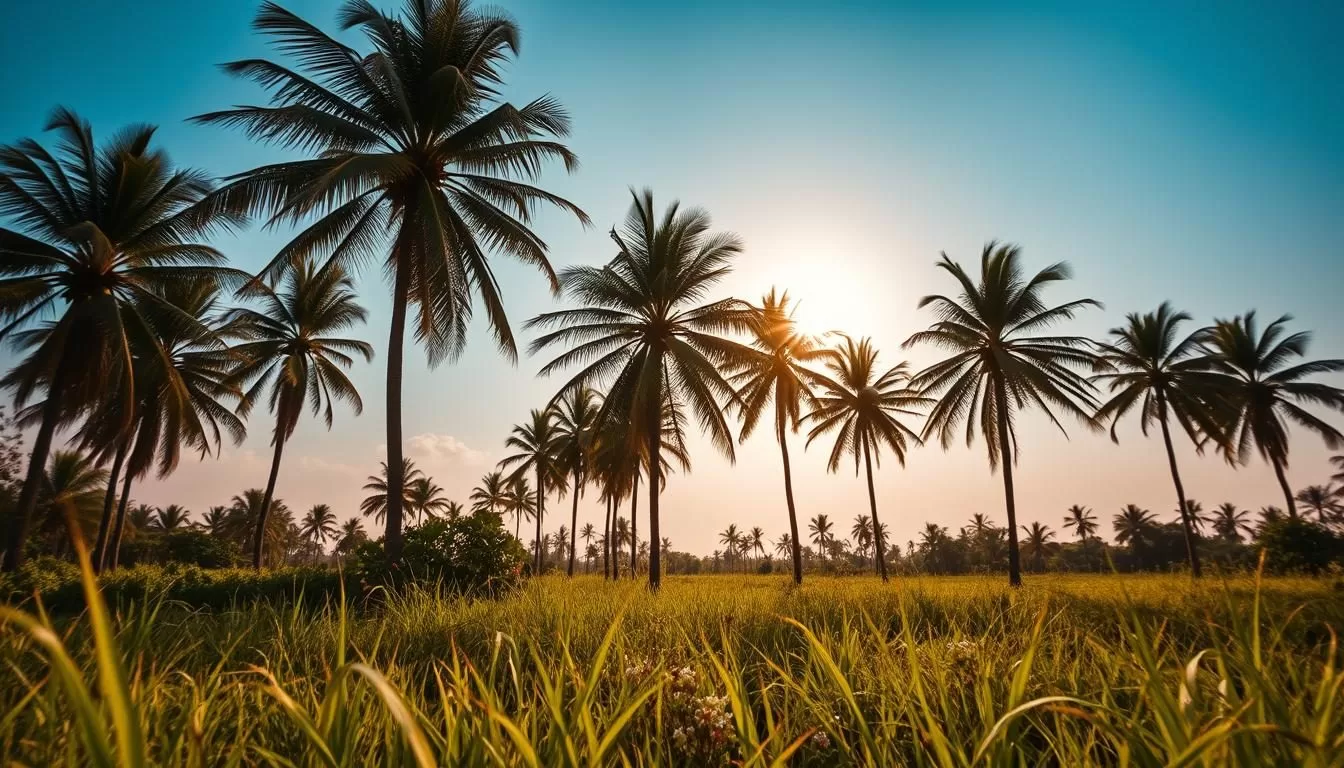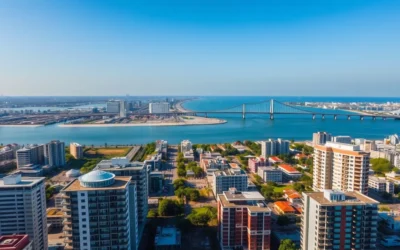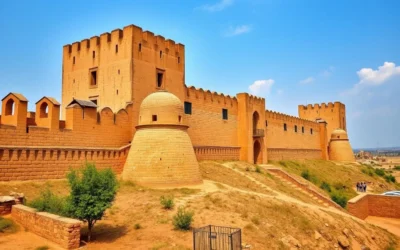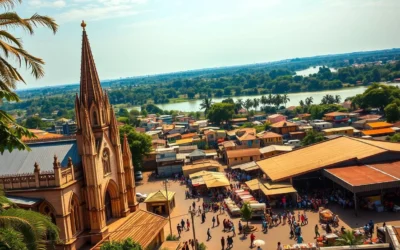✓ Accommodations✓ Flights✓ Rental Cars✓ Tours & Activities
Planning a trip to Nigeria can be a thrilling experience, but understanding the country’s diverse climate is crucial for a successful adventure.
Nigeria’s tropical climate means temperatures remain warm throughout the year, but the country’s large size results in varied weather patterns across different regions.
The wet and dry seasons play a significant role in shaping the travel experience. The dry season, from November to March, brings dry, dusty harmattan winds, while the wet season, from April to October, is characterized by heavy rainfall.
Understanding these seasonal variations is key to planning your trip and making the most of your time in Nigeria.
Understanding Nigeria’s Climate Patterns
Understanding Nigeria’s climate is crucial for planning a trip, as the country’s weather varies significantly across different regions.
Nigeria’s climate is characterized by two main seasons: the wet season and the dry season. The wet season typically runs from April to October, bringing heavy rainfall and increased humidity. In contrast, the dry season, which spans from November to March, is marked by little to no rainfall.
Tropical Climate Zones Across Nigeria
Nigeria encompasses various tropical climate zones, ranging from the arid Sahel in the north to the humid regions in the south. The climate varies significantly by latitude and altitude, resulting in diverse weather conditions across the country.
The Two Main Seasons: Wet and Dry
The two main seasons dictate the rhythm of life in Nigeria. During the wet season, you can expect heavy rains and occasional flooding. In contrast, the dry season brings the harmattan, a dry and dusty wind from the Sahara, which can make the air feel cooler but also drier.
| Season | Duration | Characteristics |
|---|---|---|
| Wet Season | April to October | Heavy rainfall, increased humidity |
| Dry Season | November to March | Little to no rainfall, harmattan winds |
Nigeria: Best Months for a Weather-Savvy Trip
For travelers to Nigeria, understanding the best time to visit can greatly enhance their experience. The country’s climate varies, but the dry season is generally considered the most pleasant time to explore.
November to January: The Prime Visiting Window
The months from November to January are considered prime for visiting Nigeria. During this period, the dry season is in full swing, offering comfortable weather conditions with low humidity. This time is ideal for exploring the country’s diverse regions, from the humid southern areas like Lagos and the Niger Delta to the drier northern regions.
You’ll appreciate the numerous advantages that dry season travel offers. With lower humidity levels, exploration becomes more comfortable, especially in typically humid southern regions.
Weather Advantages During the Dry Season
The dry season brings several weather advantages that make it an ideal time for a trip to Nigeria. Some of the key benefits include:
- Fewer mosquitoes and other insects, reducing both nuisance and health concerns related to insect-borne diseases.
- Improved road conditions, making travel between cities and to remote areas more reliable and less time-consuming.
- Better visibility for wildlife viewing and photography, although occasional dusty conditions due to the harmattan wind should be expected.
| Month | Weather Condition | Travel Advantage |
|---|---|---|
| November | Dry and cool | Ideal for outdoor activities |
| December | Cold harmattan winds | Comfortable temperatures for sightseeing |
| January | Dry and sunny | Perfect for wildlife viewing and photography |

Regional Weather Variations to Consider
Nigeria’s diverse geography gives rise to varied regional weather patterns that are crucial to consider when planning your trip. Understanding these variations will help you prepare for the different conditions you’ll encounter across the country.
Northern Nigeria: Hotter and Drier Climate
Northern Nigeria is characterized by a hotter and drier climate compared to the south. The region experiences a more pronounced dry season, with less humidity and higher temperatures, especially during the peak dry months.
| Region | Climate Characteristics | Best Time to Visit |
|---|---|---|
| Northern Nigeria | Hotter and drier | November to January |
| Southern Nigeria | More humid with earlier rains | Dry season, November to March |
Southern Nigeria: More Humid with Earlier Rains
The southern region, including cities like Lagos, experiences a more humid climate with significant rainfall. The wet season starts earlier here, sometimes as early as February or March, and can last until October. You’ll find that even during the dry season, the south remains relatively humid compared to the north.
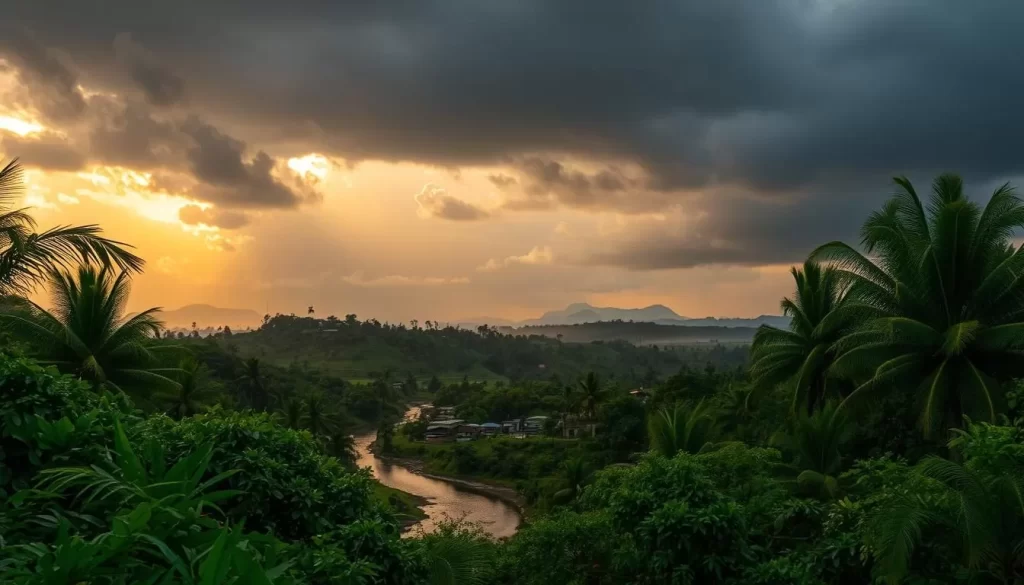
When visiting the city of Lagos, be prepared for high humidity and temperatures averaging around 32°C. The region’s beaches are best enjoyed during the dry season when rainfall is minimal.
Month-by-Month Weather Guide
A month-by-month guide to Nigeria’s weather can help you prepare for the best time to visit and enjoy the country’s diverse climate. This detailed breakdown will enable you to plan your trip according to the weather conditions that suit you best.
January-March: Peak Dry Season
During these months, Nigeria is in the midst of its dry season, characterized by hot and dry conditions across the country. January is one of the coolest months in the north due to the harmattan winds, but temperatures rise significantly as the season progresses. By March, the heat becomes more intense, especially in the northern regions. This period is ideal for visiting if you prefer dry weather, but be prepared for the rising temperatures.
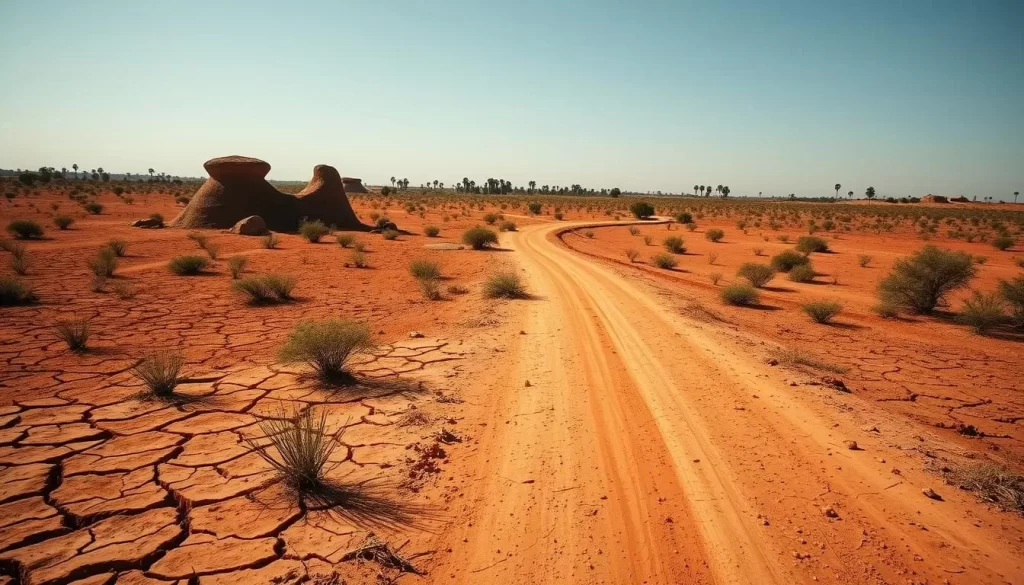
April-July: Early to Mid Wet Season
As Nigeria transitions into the wet season, the weather becomes more humid and rainy. April marks the beginning of the rainy season in the south, with July being one of the wettest months. The rain brings relief from the heat but can also cause flooding in some areas. If you’re planning to visit during this time, be prepared for occasional heavy downpours and possible disruptions.
August-October: Late Wet Season
The wet season continues through August and September, with October starting to see a decrease in rainfall, especially in the north. The landscape is lush and green, making it a beautiful time to visit national parks and enjoy outdoor activities. However, some areas might still experience significant rainfall, so it’s essential to pack accordingly.
November-December: Early Dry Season
November is a great time to visit Nigeria as the country transitions from the wet to the dry season. The weather becomes more pleasant, with a significant decrease in rainfall. By December, the dry season is in full swing, with cooler nights due to the harmattan winds, especially in the north. This period is ideal for cultural experiences, as it coincides with year-end festivities and celebrations.
Planning Your Visit Around Nigerian Festivals
Planning your visit to Nigeria around its festivals can enhance your cultural experience. Nigeria is known for its vibrant cultural celebrations, which take place throughout the year. These events offer a unique glimpse into the country’s rich heritage and traditions.
Dry Season Cultural Celebrations
The dry season in Nigeria hosts several cultural celebrations that are worth experiencing. Although the Eyo Festival typically occurs in May, which is towards the end of the dry season, it’s a significant event that showcases Lagos’s cultural heritage. The festival features thousands of costumed dancers, known as ‘Eyo,’ parading through the streets, honoring the city’s history and ancestors. You can also enjoy the music and art that accompany these celebrations.
| Festival | Date | Description |
|---|---|---|
| Eyo Festival | Varies (Typically in May) | Cultural spectacle featuring costumed dancers |
| Lagos International Jazz Festival | April | Celebration of music with various jazz performances |
| Lagos Photo Festival | Spans from wet season to November | Exhibition of photography in art galleries |
Wet Season Events Worth the Rain
Despite the rains, the wet season is filled with significant cultural events. The new yam festivals across southern and eastern Nigeria, held from June to August, celebrate the harvest season. You can experience the local culture and enjoy the festivities, even on a rainy date. The Lagos International Jazz Festival in April and the Lagos Photo Festival, which extends into November, offer indoor and covered venue events, making them ideal for the wet season.
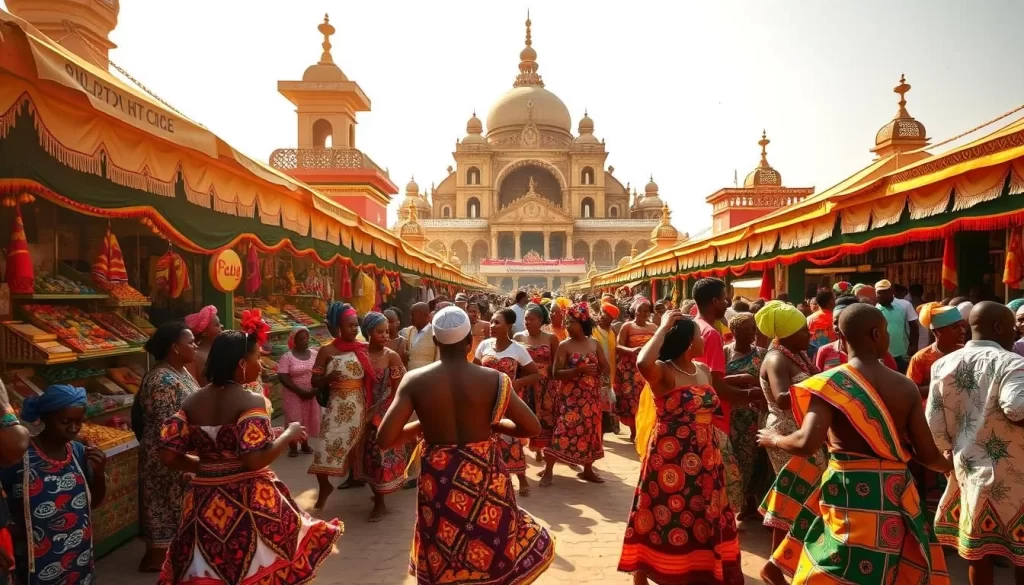
These festivals provide a unique cultural experience with fewer tourists, making for a more authentic local atmosphere. You can enjoy the vibrant culture of Nigeria by attending these events, regardless of the season.
Weather-Based Packing Tips for Nigeria
To make the most of your trip to Nigeria, understanding the weather and packing accordingly is key. The country’s climate varies significantly across different regions and seasons.
Dry Season Essentials
During the dry season, lightweight and breathable clothing is recommended. You’ll want to pack clothes that protect you from the sun, such as long-sleeved shirts and pants, along with a hat and sunglasses. Moisturizer is also a must due to the dry air.
Wet Season Must-Haves
For the wet season, prioritize waterproofing and quick-drying items. A lightweight, packable rain jacket or poncho is essential. Consider waterproof footwear like quick-drying sandals or water-resistant shoes. Pack clothing in quick-drying fabrics and bring extra sets. Don’t forget insect repellent with DEET to combat increased mosquito populations.
Top Destinations Based on Seasonal Weather
Nigeria’s diverse climate means that the best time to visit varies greatly depending on the region you’re planning to explore. The country’s tourist attractions are spread across different climatic zones, making it essential to plan your trip according to the season.

Lagos and Southern Coastal Areas
The southern coastal areas, including Lagos, are best visited during the dry season, from November to March, when the weather is relatively dry and sunny. This period is ideal for exploring the region’s beautiful beaches and cultural attractions.
Abuja and Central Nigeria
Abuja, the capital city, and central Nigeria experience a relatively mild climate during the dry season. It’s an excellent time to visit the region’s cultural and natural attractions, such as the Aso Rock and Zuma Rock.
Northern Nigeria and Yankari National Park
Yankari National Park is a must-visit during the early dry season (November-January), when wildlife congregates around water sources. The region’s extreme temperature variations make it crucial to plan your visit carefully, avoiding the scorching heat from March to May.
Conclusion
Timing is everything when it comes to exploring Nigeria, a country that boasts a complex and rewarding travel experience. You’ll find that visiting between November and January offers the best balance of comfortable weather and accessibility across all regions.
As you plan your Nigeria travel, remember to account for regional climate variations and the country’s rich cultural tapestry, shaped by over 250 ethnic groups. Whether you’re drawn to Nigeria’s cultural heritage, natural landscapes, or urban experiences, aligning your visit with the right season will enhance your appreciation of this diverse nation.
To ensure a smooth journey, prepare for practical aspects such as visa requirements, currency exchange, and language differences. With careful planning, you’ll be able to fully immerse yourself in Nigeria’s vibrant culture and unforgettable experiences.
The above is subject to change.
Check back often to TRAVEL.COM for the latest travel tips and deals.
